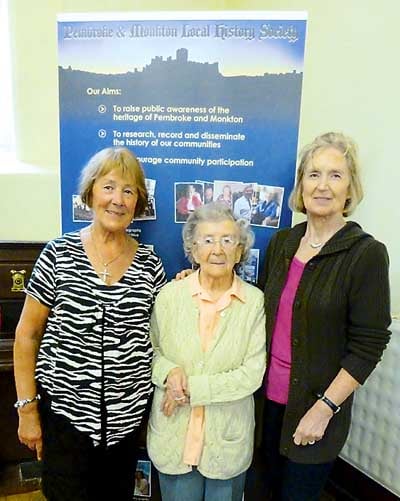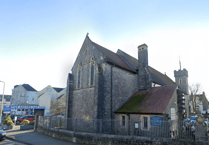The age of steam trains
Last week, I wrote about the formation of the old Pembroke and Tenby Railway Company, the old P&T and its opening way back in 1863, 150 years ago. The end of the P & T came in 1897 when it was taken over by the GWR which in turn ceased to exist in 1948 when railways were nationalised. Good old British Rail - how people used to complain but now regret its disastrous break up in the '90s.
I was born at the tail end of the age of steam and steam trains form part of my childhood memories - how we loved them! If a train was due in we would rush to the station to see it arrive, the noise, smell ... I remember the Paddington Express steaming in, the dining car all set for dinner, I used to think it was wonderful. A trip to Swansea on the train was a real treat - we used to have a clothes shopping trip once or twice a year. Full of excitement, we would climb into one of the brown and cream carriages which at that time were fitted out in compartments with glass sliding doors. Cars were few and far between in those days and no one really aspired to own one. To be an engine driver on the other hand was many a lad's dream - how times have changed!
Working on the railways
The railway had a huge impact in its day - connecting communities, transporting goods on a big scale, a vital element in the economic success of towns throughout the land: an important part of Pembroke life therefore and a necessary chapter in our history project 'Through my Eyes: a community history of Pembroke and Monkton'. We were fortunate therefore that Elfyn Jenkins, who once worked on Pembroke Station, agreed to give us his story, a story which began back in those halcyon days of steam.
Elfyn began his career with the railways when just 14. "When I left school in 1944 I got a job in Swansea station as a messenger boy with the GWR," he told me.
"Most of my family were employed on the railways so that came as no surprise. I worked my way up, later working at Port Talbot then Pembroke where I was appointed foreman in 1958."
Pembroke Station
It is hard to believe now, but Pembroke was a very busy station employing 14 staff when Elfyn was appointed Foreman in 1958.
"The stationmaster was Mr. Ernest Williams," continued Elfyn, "then there were the Clerks, Glyn Cook and Dai Roblin; Leslie Thomas and Evan Rees the Porters; Billy Morris and Alan Cole the signalmen, with Garfield Thomas, the relief signalman. We had a large animal feeds' warehouse in the Upper Yard and that was operated by Granville Howells.
"In addition, there were our drivers: we had three lorries which were driven by Fred Stephens, Joe Elliot and Jim Richardson and they would unload goods from the wagons and deliver them all over the district. There was also a parcels van driven by Ozzie Williams.
"It was my responsibility to keep the yard in good working order - much of it is has been sold off now, but then it was quite extensive with five sidings, stretching eastward towards Lamphey. These would enable trucks to be shunted directly into the livestock pens (Pembroke had a cattle market then), to the cement silo, to Colley's sawmills, where Jewsons now stands. Merchants like Wally Simons, Western Counties had their own warehouses, as did British Rail."
Catering for everyone's needs
"So much freight came in and out of Pembroke - everything that was needed in and around Pembroke came by rail including coal, oil, timber, cement, general goods and parcels, animal feed, fertilisers and produce. Bennion's farm for example would have six trucks a day coming in with produce and leaving with sugar beet and there would be truck loads of seed potatoes for various farms. Then there were the special trains for the Pembrokeshire new potatoes during the height of the season. Even beer from Burton-on-Trent came in by train, subsequently distributed by lorry to the pubs in Pembroke and area. Shunting could be quite hectic making sure all the merchants had their goods!"
The mail and the military
Then of course the Royal Mail would come in and go out on every train. There was also a lot of military traffic. During the wars, much use had been made of the railways and this had led to the laying of extra track with a new loop added in WW2 which was nicknamed the Burma Road, a siding long enough for 46 wagons.
"Troop trains continued to use the station well after the war," continued Elfyn, "tanks, artillery and Territorial Army personnel all bound for Castlemartin. After the troops had detrained, I would shunt the train back up to the Burma Road, unhitch the engine, go down then to Pembroke Dock, on the turntable, come back the right way then back to the top end of the Burma Road. I then would operate the ground frame and prepare the engine for its journey back."
He particularly remembers the arrival of the Argyle and Southern Highlanders.
"What a sight that was with crowds at the station to see them and Smokey Joe there with his van selling tea!"
Arrivals of note
Some arrivals were most unusual, on one occasion the Circus Train arrived carrying Bertram Mill's Circus which was held on The Commons - this was around 1958.
Royalty also alighted at Pembroke station. The newly-crowned Queen and Duke of Edinburgh came in on the royal train on her tour of 1955. While this was before Elfyn worked there, he did meet the Duke of Edinburgh when he got off at Pembroke en route to the tank range at Castlemartin in 1960, and in 1964, The Queen Mother arrived at Pembroke when she came to open the Power Station.
The end of an era
Elfyn was to witness great changes in the railways during his happy years at Pembroke Station. Steam trains were being replaced by diesel multiple units (DMUs) and in 1963 the last steam passenger train passed through Pembroke station driven by Bryn Hall. It was the end of an era.
This was also the time of the Beeching cuts. Road transport was making a big impact as more and more goods were being transported by lorry. Government policy favoured road haulage and the cuts to the railways were savage. We were in danger of losing our line, but the advent of the power station and refinery helped to save it as the steel needed to build them came in by rail.
But the writing was on the wall. Elfyn told me that Ernest Williams advised him to leave which he did on being offered a job as a store keeper in the power station.
"I missed working for the railway though" he added "it was a way of life, hard work but I enjoyed it."
When you look at Pembroke Station today, it is hard to believe that it was once such a busy place, indispensable to the economic life of town and district. No one now works on the station and there is only a bus shelter where once the lovely, old Victorian building once stood. It was demolished in 1971, another of Pembroke's lost buildings.
Contact
If you have any stories, photographs or feedback for this column, please contact me, Linda Asman, on 01646 622428, email [email protected]">[email protected] and visit our website http://www.pembrokeandmonkonhistory.org.uk">www.pembrokeandmonkonhistory.org.uk
Next event
Friday, May 17, 7.30 pm, quiz night at Monkton Church Hall. £3.50 includes a buffet - bring your own bottle if you wish.





Comments
This article has no comments yet. Be the first to leave a comment.